First aid for puncture wounds
What is a puncture wound?
A puncture wound occurs when an object pierces the skin and enters into the body. This creates an open wound which is painful and may be bleeding.
Punctures may occur due to any sharp objects such as glass, scissors, knives, pins, nails, wood splinters and sharp stones. The object may remain embedded in the wound or may have passed clean through the body part involved.
Puncture wounds can be dangerous as it is difficult to tell how deep the injury is. Damage to underlying blood vessels can cause serious bleeding to occur.
Symptoms of Puncture Wounds
The symptoms associated with a puncture wound depend on its severity and location. Some of the common signs of puncture wounds include:
- Mild bleeding
- Pain at the wound site
If the patient ends up having an infection, they could experience these symptoms:
- Redness of the skin
- Warmth
- Drainage of the pus
- Swelling
First aid for a puncture wound
- Do not remove the object unless it is very small (for example,a small splinter)
- Stop the bleeding by applying pressure around the wound – take care not to dislodge the object
- If possible, elevate the limb to prevent further blood loss
- Seek urgent medical attention
It is important to keep the object as still as possible to prevent further injury to the deeper structures below the skin and minimise any bleeding.
Whilst it is tempting sometimes to attempt to remove the object, this can actually worsen the situation by causing further bleeding and tissue damage. Removal of embedded objects should only be carried out by a qualified healthcare professional.
Puncture wounds are at a high risk of becoming infected. Seek early medical advice if there are any signs of infection such as swelling, warmth, pain or discharge.
Treatment for Puncture Wounds
After a healthcare provider takes a look at a puncture wound, they will then provide further instructions on how to treat it properly at home.
Home treatment for a puncture wound is based on:
- The size and location of the wound.
- The type of treatment required by the patient.
- The presence of any special needs mentioned by the doctor.
They could suggest antibiotics to prevent the formation of infection in the wound. The following are the things to remember while treating a puncture wound at home:
- Keep the wounded area dry and clean.
- Follow the instructions from your healthcare provider while treating the wound.
- If someone around you has suffered from a puncture wound, make sure they avoid participating in any activity that could cause the wound to be reopened or reinjured.
- Be observant about signs of infection, including redness, swelling, increased warmth, pain, or leaking of fluid.
Can I Put Ice on a Puncture Wound?
Once the wounded area has been thoroughly cleaned with soap and water, you can apply ice if there is swelling. Make sure to keep the punctured region elevated.
How to Treat a Puncture Wound Naturally?
If you have a minor open wound, such as a cut or a scrape, there are certain natural or home remedies you can resort to. These natural remedies are as follows:
Aloe Vera
- Aloe vera has soothing, anti-inflammatory, and analgesic properties that help with the healing process.
- The phytochemicals present in aloe vera gel aid in reducing inflammation and easing the pain.
- Just apply the aloe vera gel on the open wound and let it dry.
Honey
- Honey has anti-inflammatory, anti-fungal, and anti-bacterial properties, and it functions as an antiseptic agent to treat open wounds.
- It dehydrates and kills the bacteria around the wounded region.
- You can apply honey every day on the open wound before washing it.
Turmeric
- Turmeric contains antibiotic and antiseptic qualities that have been employed for medicinal purposes for years.
- If you have a bleeding wound, apply turmeric to it and watch the bleeding stop instantly.
- You can also consume a glass of turmeric milk every night before going to bed to help with the healing.
Coconut Oil
- Coconut oil has anti-bacterial, anti-inflammatory, and moisturizing goodness that helps in calming the pain and keeping infections away. It can also help in preventing scars.
- Just apply the oil on the affected area and use a clean cloth to cover it.
- Coconut oil can be reapplied on a wound twice or thrice a day.
Garlic
- With its antibiotic and anti-microbial properties, garlic can help instantly stop the bleeding that occurs due to a wound. It also aids in promoting the healing process and reducing the pain.
- Garlic has the ability to boost the natural defenses of the body so that it can fight against infection.
- If you have a bleeding wound, just crush about two to three garlic cloves and apply them over the wound.
Tea Tree Oil
- Not only is tea tree oil a popular product in the beauty industry, but it also helps in healing open wounds and minor cuts.
- It’s filled with anti-bacterial, antioxidant, and anti-inflammatory properties.
- Apply a drop of it on the open wound so that it heals faster.
Prevention for Puncture Wounds
The following are some of the ways in which you can prevent puncture wounds:
- Always wear protective gear while playing sports.
- When you’re wearing shoes, make sure they have sturdy soles that can’t be punctured by nails.
- Always put on proper safety equipment and shoes while using heavy machinery or tools.
- Clean away the debris quickly if there has been an accident, such as if there is broken glass around.
- If something spills, especially on a slippery surface, ensure to dry it up right away before walking or running on it.
FAQs
- What is the difference between a puncture wound and a penetrating wound?
A puncture wound results from a sharp object which punctures the skin but doesn’t reach the body cavity. A penetrating wound, on the other hand, goes into the body cavity, leading to the formation of an open wound.
- What is an example of a puncture wound?
An example of a puncture wound is a wound caused by a sharp object like a nail.
- What causes a puncture wound?
Puncture wounds can be caused by sharp objects such as needles, nails, teeth, ice picks, tacks, and knives.
- What is the most common puncture wound?
One of the most common puncture wounds occurs when a person steps on an object, thereby puncturing the sole of their foot.
- Do puncture wounds swell?
The punctured area could get swollen or bruised in some cases.
- Do puncture wounds bleed?
Puncture wounds don’t cause a lot of external bleeding unless the puncturing of a major blood vessel is involved.
Conclusion
Most minor puncture wounds don’t require treatment beyond homecare and first aid. However, there are some situations where you might require immediate medical attention, and those scenarios include:
- If your bone, tendon, or muscle is exposed.
- If there is impaired function or feeling in the wounded area.
- If there is heavy bleeding or spurting and if it doesn’t stop even after 10 minutes of applied pressure.
Get in touch with your doctor right away under the following circumstances:
- If there is debris stuck in the wound.
- If you haven’t had a tetanus shot in a decade.
- The wound occurred due to a fishhook.
- If you stepped on a nail or a similar object.
- The wound was due to a bite.
- The wound begins to display signs of infection.
Make sure that you and your children are up to date on all your vaccinations, and don’t forget to get your tetanus shot once every ten years.

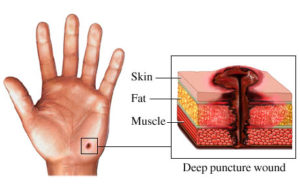
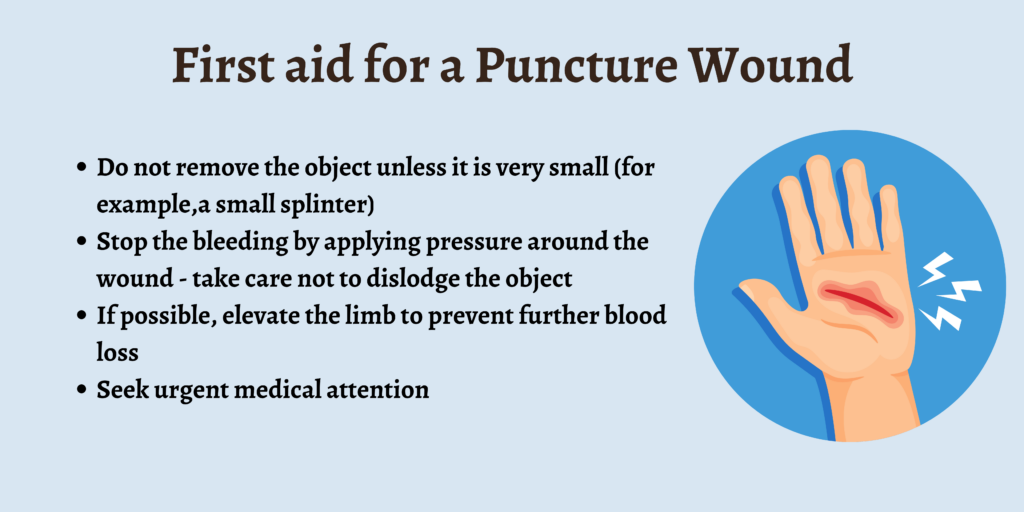
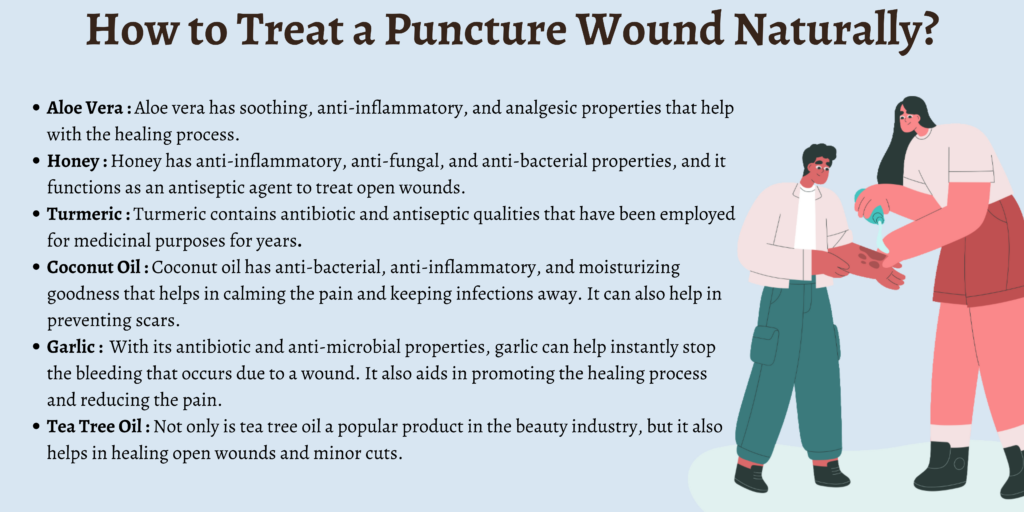

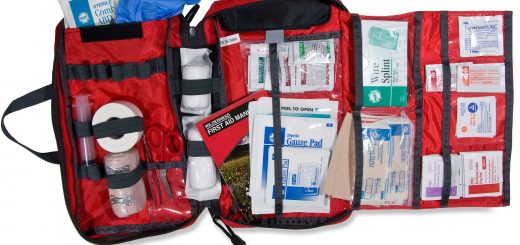
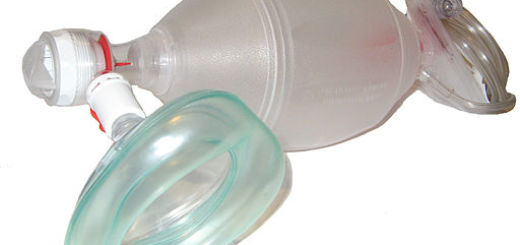


This is good information to know! Since you typically can’t apply pressure directly to the wound – for fear of displaying the lodged in object – are there any specialized methods for it?
I cringe when television shows and movies show people pulling objects out of wounds. The rarely show the the aftermath, with blood gushing out because the object was keeping pressure on the severed blood vessels.
Remember, if an object must stay in place, it must be stabilized to keep it from moving i around and making the wound larger!
Thanks for providing the concise overview on how to apply first aid for puncture wounds! Even though most of the concepts are easily comprehensible, it’s amazing how many people may forget these fundamentals should a more serious puncture arise.
Natural instinct would be to pull out the object pierced into the skin as quick as possible, but like it’s stated here, what we would cognitively define as a practical way to stop the problem ends up making the situation worse. And another surprising thing is that some people leave an open wound without seeking professional help. I remember a friend that had a toe cut and decided it wasn’t going to be a problem.
It was until he went to the beach that it got infected, and he had to spend a few weeks getting it healed. Things like this, despite of how common sense they are, are vital to avoid those types of circumstances. So thank you very much for providing this here! And I’m looking forward to seeing more useful information throughout this blog!
I’ve always seen this conducted in entertainment media, but I haven’t really absorbed the information on how to handle a situation like this in case I find myself in it. I, however, am aware that you should never remove anything from a puncture wound, especially if the wound is deep because it could be the difference between destroying or injuring organs or arteries or simply the balance between life and death. So I’m here reading this post and finding it very valuable to my knowledge regarding the proper steps to take when handling such wounds.
My dad was a Hunter Safety teacher so I sat through many courses while he taught and being pretty young when I was doing this, I always remember the hunter tripping and falling on a stick. Thinking his gun would go off because it was a “hunter” safety course, the stick punctured him instead. His hunting partner was going to pull it out, but the victim told him not to.
This is very useful information to know as this type of accident can happen and anytime and any where. Not knowing how to take care of something like this could ultimately lead to death.
This is so scary. But I’m glad I know what to do now. I remember when I was little, seeing a little boy with a pencil stabbed through his hand. The nurse held it steady while she walked him out to the parking lot. This will definitely come in handy if this nightmare ever happens.
Great information! I think most people’s first reaction is to take it out, when that can do more harm than good. You don’t know if that object had severed any major blood vessels. Great post!
I had a medium size splinter on my left leg when I was 12, the size of half a finger. The skin around it was bluish and purple-ish. I didn’t want to let my parents know so I pulled it out myself. And it bled endlessly and my parents were so upset. The doctor said I am lucky not damaging any tissue. Now I’m a parent myself, I know what to do with my children when (cross finger) it happen. Thank you for letting us know.
What if the object in the wound is big and I may fear to put pressure on the wound in order to prevent bleeding, How else can I do it?